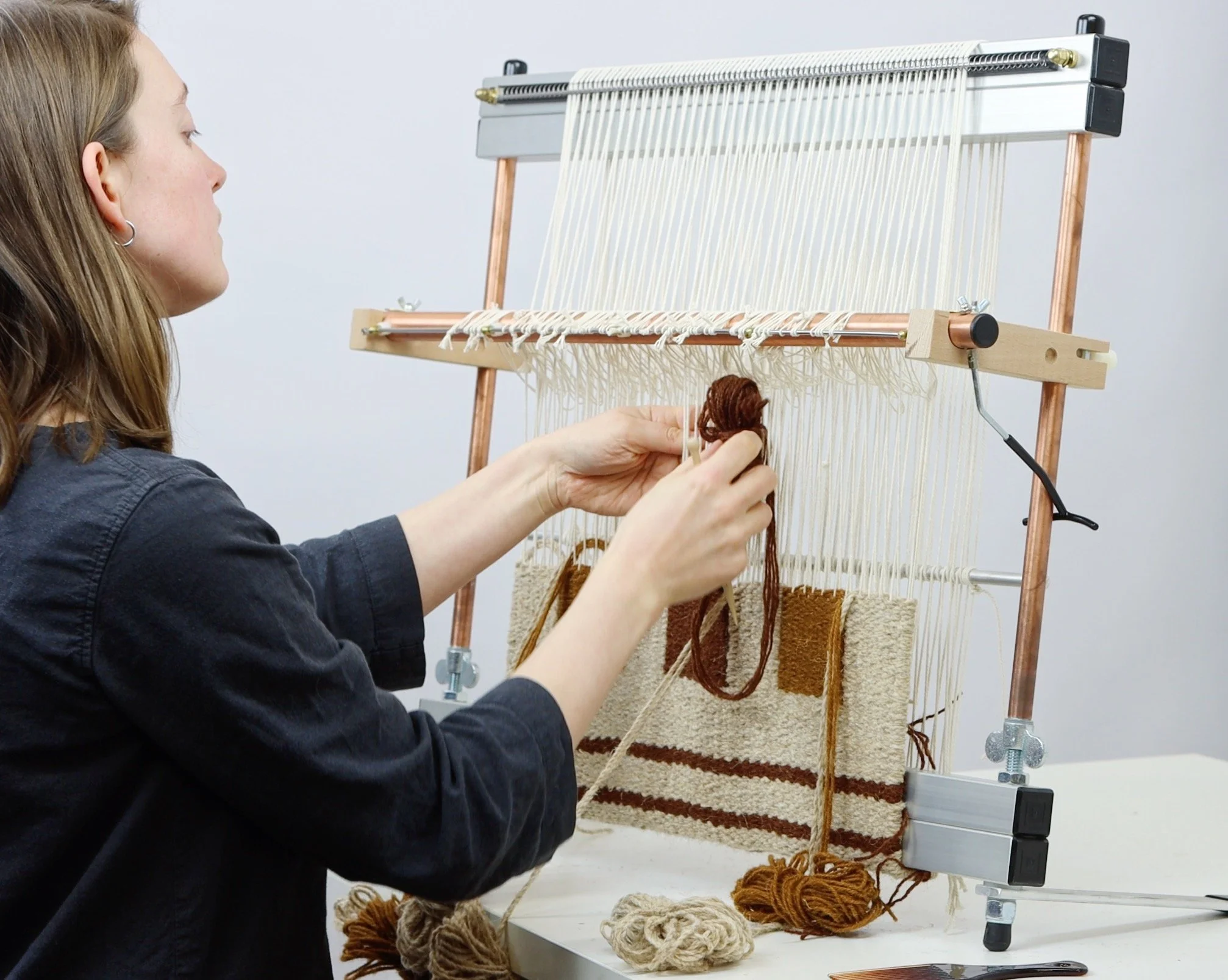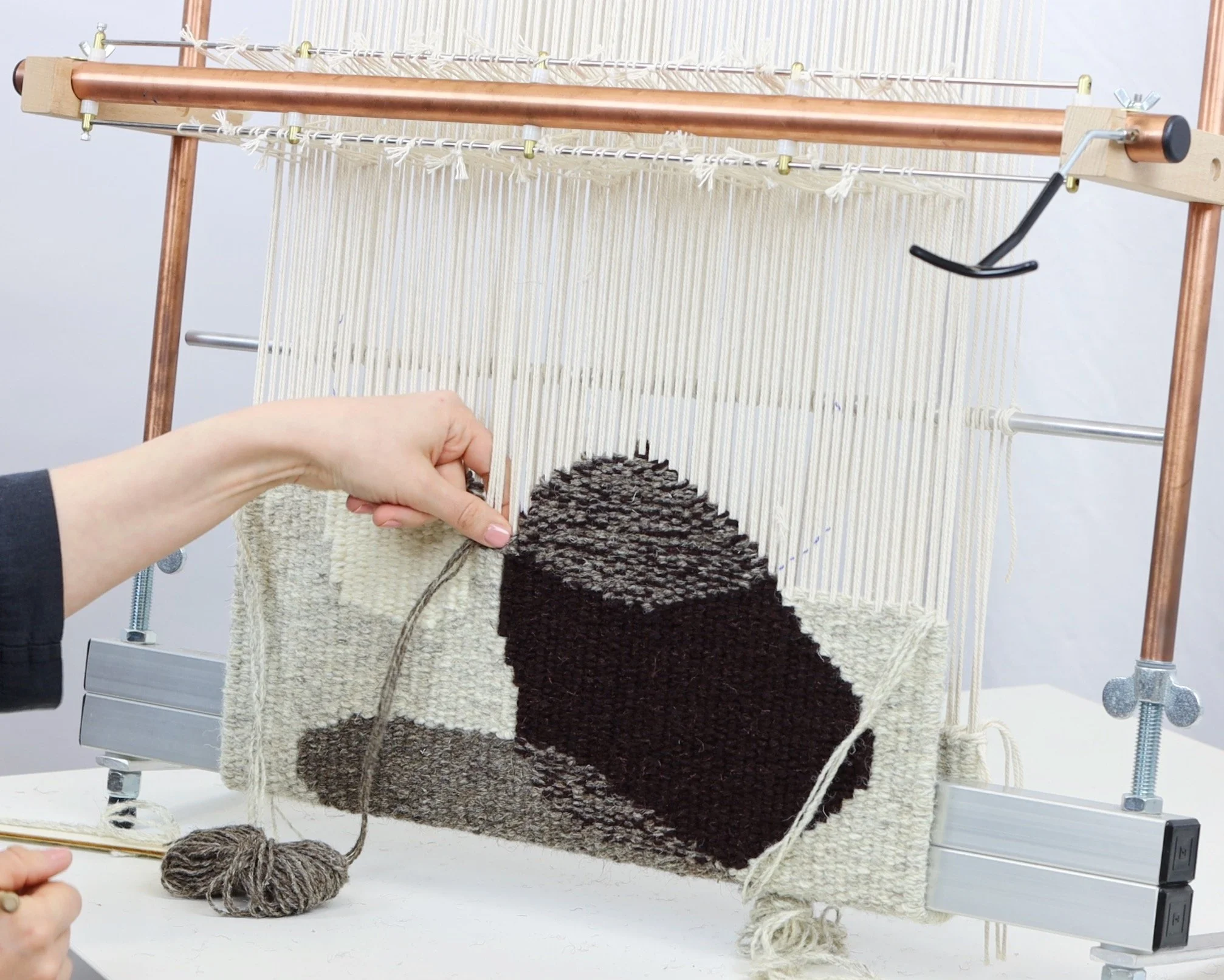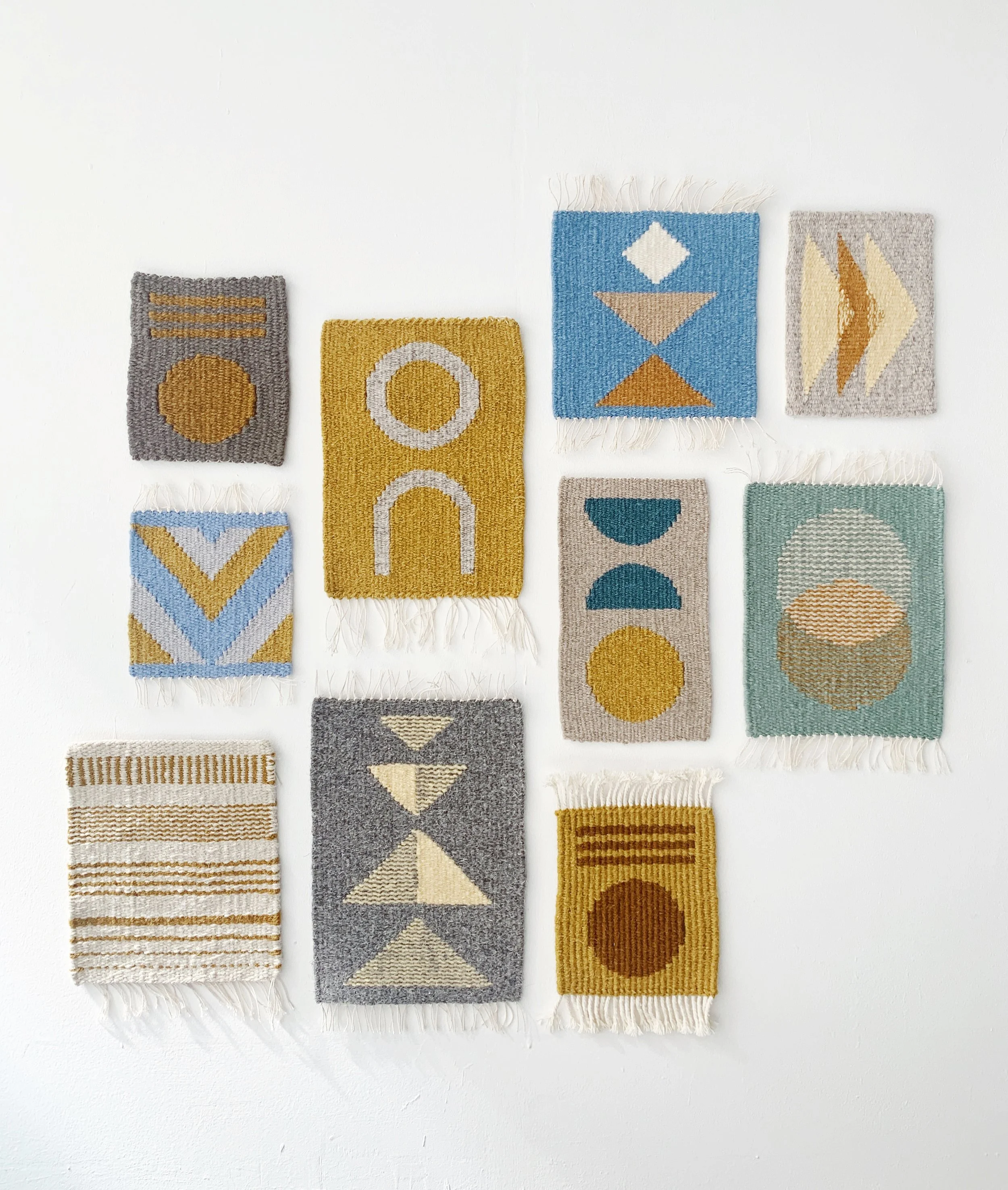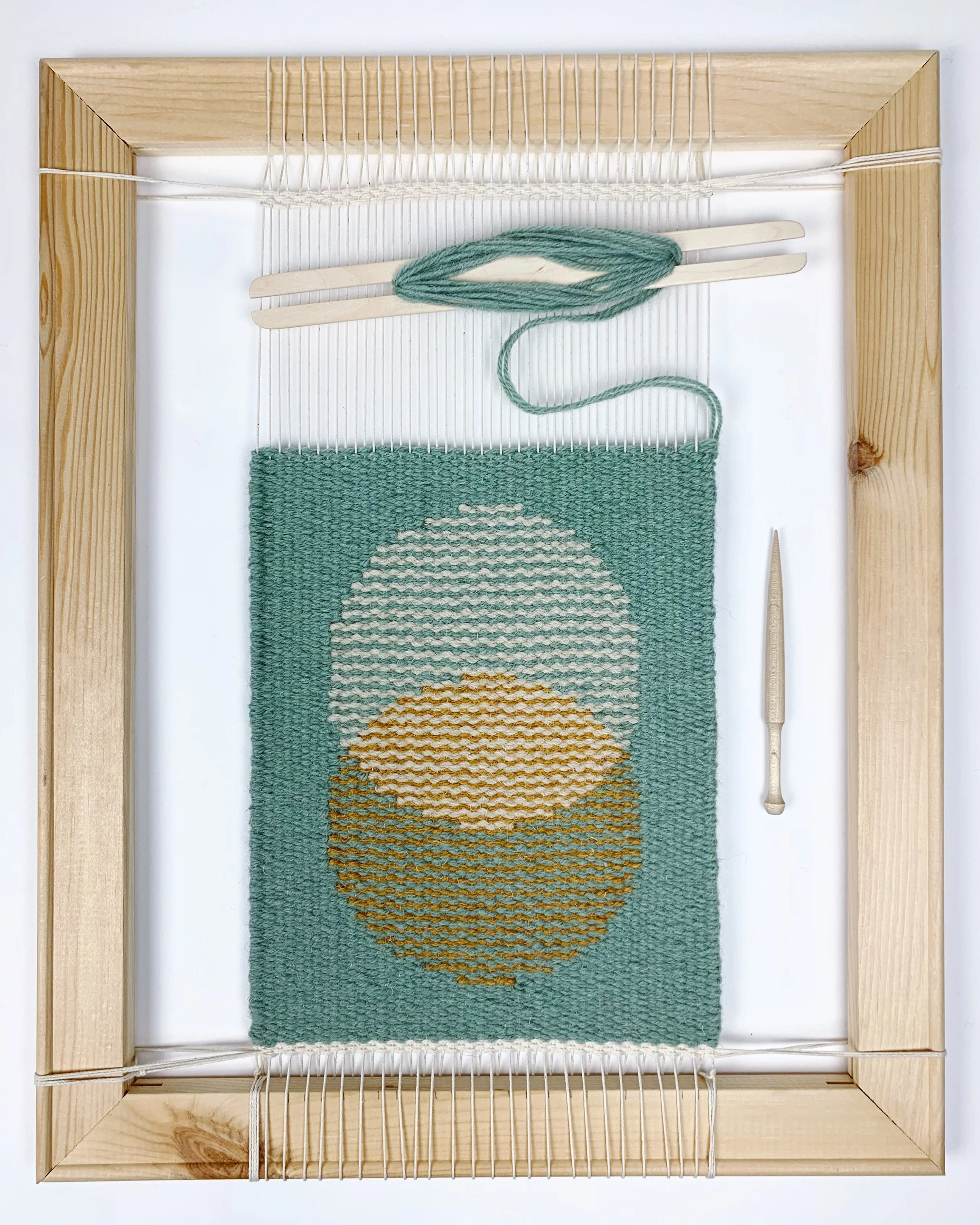RUG WEAVING ON A MIRRIX LOOM
An in-depth online weaving course, showing you how to use your Mirrix loom to weave unique rugs. You’ll learn how to set up your loom for rug weaving, hone your skills and build from basic up to advanced weaving techniques.
Created in partnership with Mirrix Looms







This course begins on Monday 12th January 2026
Enrolment will close on January 11th 2026
sign up before then to get lifetime access!
About This Course
Rug Weaving On A Mirrix Loom covers how to warp your loom in 4 different ways and weave 8 different sample rugs with 4 different finishing methods.
Each rug will combine multiple patterns and techniques, with downloadable templates that students can follow or customise however they like.
Along the way, I’ll be sharing what I’ve learnt in almost a decade of weaving professionally, and answering your questions over email and dedicated discussion threads!
Each video is pre-recorded and close captioned, so you can watch at your own pace, as many times as you need.
PDF workbooks are included for you to download with each module, along with templates to guide you as you weave.
If you need additional help and guidance, I’ll be answering student questions via email and in the discussion threads at the end of each module.
Best of all, you get lifetime access to all course content, so you can come back to the course as many times as you need.

Included In This Course
18 Pre-Recorded Videos
These videos cover the full process of rug weaving on a Mirrix loom from start to finish, including 8 different sample rugs. Closed captions and transcripts are available for each one.
10 PDF Templates
Each video comes with PDF templates to show the full design of the rug, and additional templates are provided for cut-out shapes to guide you as you weave.
Video Discussion Threads
At the end of each module there is a discussion page dedicated to that module, where you’ll be able to share your work and get feedback. You can also ask questions in the comments underneath each video.
Email Support
There is a dedicated email address where you can get in touch and ask questions
Lifetime Access
Your access to the course will never expire and you’ll be able to come back to it as many times as you like.
What You’ll Need
A Medium to Large Mirrix Loom - You will need a loom with a minimum weaving width of 16”. I am using the 28” McKinley Loom.
Extended Shedding Device - This creates a bigger shed to enable you to weave easily across the loom.
4dpi & 5dpi Warp Coils - Different warp coils are used at various points in the course. Coils can be purchased from Mirrix here.
Warp Yarn - all the rugs are woven using 2mm cotton cord, one rug is woven with 3mm cotton cord. You will need at least 500g of 2mm cotton cord to start with.
Weft Yarn - I am using DK and Aran weight rug yarn. You will need approx 300-400g of weft yarn for each rug.
Weaving Tools - flat stick shuttles, a bobbin, a comb, a tapestry needle and sharp scissors.
I have a small number of course & kit bundles available in my online shop.
But you can also browse my recommended stockists and suppliers here

I've never woven before. Is this course suitable for me?
Yes! This course is designed for beginners and experienced weavers alike. You can also take the Intro To Geometric Weaving online class first, before , to try out weaving first without committing to the full course.
Can I use a different loom for this course?
I am using the 28” McKinley loom for this course but there are other looms available that work in a similar way! If you have a Schacht Tapestry Loom or an Ashford Tapestry Loom you can use one of these as well.
You could also adapt the instructions in this course for a rigid heddle or simple frame loom. However, to get the best results I recommend using a loom that allows for continuous warping, like the Mirrix loom.
How is this course different to your previous rug weaving course?
The previous course focused on weaving on a Balfour & Co rug loom (now discontinued.) Here, every rug is woven on a Mirrix loom and we explore certain processes that are specific to this loom. The rug designs themselves are also distinct, covering several different patterns in one rug, and more advanced techniques than the earlier course.
Can I use a different size of Mirrix loom for this course?
I am using the 28” McKinley loom for this course but you can use a Mirrix loom that is larger or smaller than this! Just make sure it is a loom with a minimum weaving width of 16” so you can weave the rug samples covered in this course.
What size warp coils do I need?
For this course you need a 4epi (for use in Modules 1 & 3) and a 5epi warp coil (used in Modules 2 & 4) These can be purchased from Mirrix here.
Can I download the modules?
Each module comes with a downloadable PDF workbook, so you can have step-by-step instructions and notes to hand while weaving. However, the videos themselves cannot be downloaded. Our videos are hosted on a platform similar to Youtube - if your internet connection is not strong enough to watch Youtube, it will not be strong enough for this course. Please check this before you sign up!
Course Contents
When you sign up for the course, you get instant access to Modules 1 & 2. Subsequent modules are uploaded each week, to give you plenty of time to work through each one.
You'll be notified by email when the next module is available, and you have lifetime access to all course content! So you can keep coming back to the course as many times as you like.
Module 1 - Getting Started
5 videos & 1 downloadable PDF
1.1 Looms, Tools & Materials - what you’ll need for this course
1.2 Design & Inspiration - planning your designs and gathering inspiration
1.3 Planning and Preparation - planning your warp & preparing your weft
1.4 Warping Your Frame Loom- warping your frame loom at a sett of 6epi
1.5 Starting To Weave- beginning your first tapestry and honing your technique
Module 2 - Simple Geometric Shapes
5 videos & 1 downloadable PDF
2.1 Lines and Blocks - weaving lines across the loom and blocks of separate weft
2.2 Triangles - weaving triangles and diamonds
2.3 Gradients - constructing diagonal slopes of different gradients
2.4 Circles & Curves - how to weave symmetrical circles and curves
2.5 Finishing Your Tapestry - taking your tapestry off the loom and finishing the loose ends
Module 3 - Striped Geometric Shapes
5 videos & 1 downloadable PDF
3.1 Troubleshooting Your Weaving -fixing problems as they arise on the loom
3.2 Interlocking & Hatching - joining weft sections with interlocking and hatching
3.3 Stripes & Pick-and-Pick - weaving shapes with stripes
3.4 Striped Triangle - creating striped and half-striped triangles
3.5 Striped Circle - weaving circles half-striped and half-solid
Module 4 - Advanced Geometric Shapes
4 videos & 1 downloadable PDF
4.1 Overlapping Shapes - using stripes to create overlapping effects
4.2 Outlining Triangles - weaving more detailed designs with triangles
4.3 Archways - how to weave repeated archway shapes
4.4 Winding Lines - weaving a winding line with cardboard cut outs
Module 5- Finishing & Display
4 videos & 1 downloadable PDF
5.1 Finishing Methods - different ways to finish your tapestries when they come off the loom
5.2 Simple Display Methods - quick and easy ways to display your tapestries
5.3 Hanging Your Tapestry - hanging your tapestries from a dowel or velcro hanging rail
5.4 Framing Your Tapestry - framing your tapestries behind glass or with a fabric backing board


